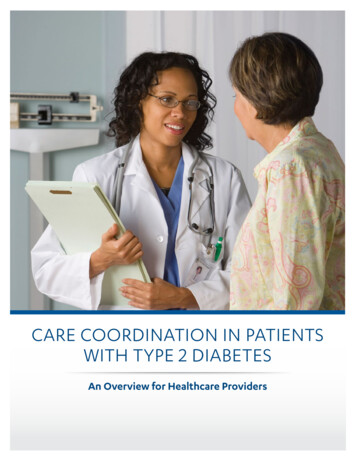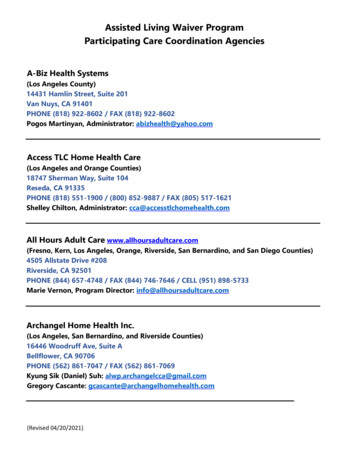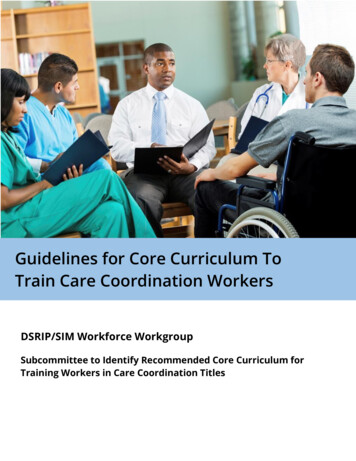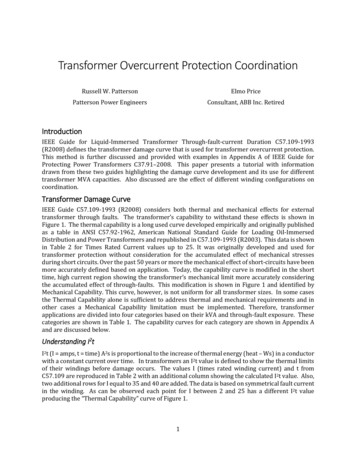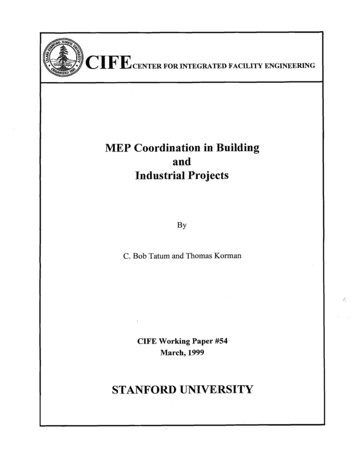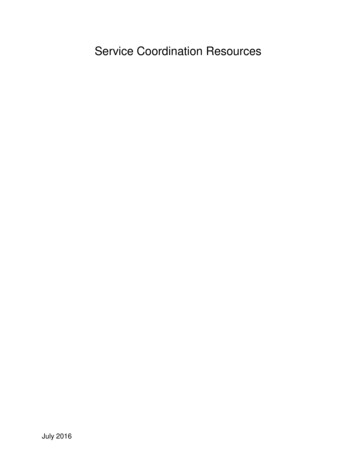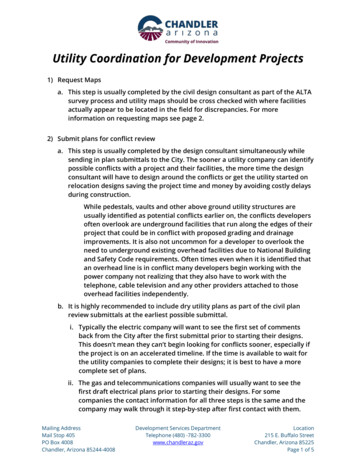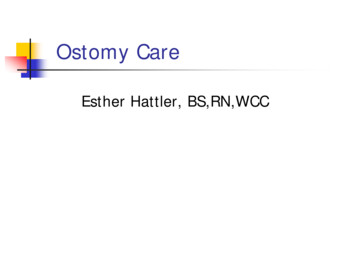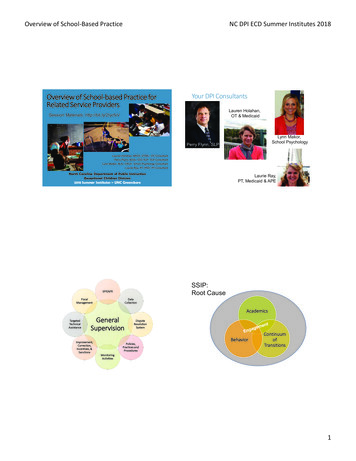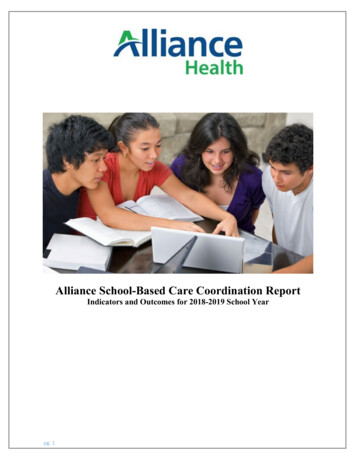
Transcription
Alliance School-Based Care Coordination ReportIndicators and Outcomes for 2018-2019 School Yearpg. 1
Executive SummaryThe purpose of the School Based Care Coordination (SBCC) team, in partnership with WakeCounty Public School System (WCPSS), is to identify and connect qualifying WCPSS studentsto behavioral health services. There are 7 program groups outlined in this report: Traditional,Traditional I/DD, Crisis, Psychiatric Residential Treatment Facility (PRTF), Diversion,Alternative Schools, and Family Partner Programs. The Traditional program works to connectstudents referred through the schools to behavioral healthcare providers who can assess andrecommend appropriate treatment with the ultimate goal of improving their engagement inschool. The Traditional I/DD program works to connect students and families referred by theSpecial Education department to community resources, behavioral healthcare providers, andassist to navigate the I/DD eligibility process. The Crisis program works to connect studentsreferred from crisis facilities in partnership with Wake County Public Schools to support thechild’s transition to appropriate level of treatment services and provide necessary supports asidentified by the school system. The Crisis program has developed a uniform process withWCPSS to support significant school safety concerns. The PRTF programs seek to identifyWCPSS students in PRTFs to ensure a quick and coordinated re-enrollment after they leave thefacility. The Adult Diversion program obtains referrals from Wake County School ResourceOfficers with the goal of diverting 16-17 year olds who commit non-violent offenses at schoolfrom getting charges in the adult system. In addition, SBCC continues to develop two specialtyprograms. These are the Alternative School and Family Partner programs. All programs workwith youth from a variety of insurance networks both in and out of the county including private,uninsured, Healthchoice, and families identified in both the tailored and standard plan Medicaidpanels.Process data, indicators, and outcomes are included in this report, as outlined in the data analysisplan created and agreed upon by Wake County Public Schools, Wake County Government, andAlliance Health, revised in 2018. The plan was revised to reflect changes in responsibilities foroutcome data. Those changes are noted throughout the report.Of note, the SBCC Team won a statewide Program of Excellence, Partnership to ImproveServices award from the NC Council of Community Programs (now called the I2i InnovationsCenter) in December 2017. The Team was also invited to speak to the NC General Assemblyabout their work, particularly children in crisis.Crisis ProgramReferrals for the Crisis Program:The SBCC program was allocated additional funding by Wake County Government at the startof the 2018-2019 school year to further develop a crisis program. The SBCC Crisis program hasexpanded over the 2018-2019 school year in an effort to meet the needs of the increasing numberof child crisis admissions in our community. During this time SBCC has added two crisis liaisonpositions, one of which is embedded at Holly Hill Hospital and the other at WakeMed Hospital.Our liaisons have access to clinical records across multiple hospital systems and crisis facilitiesthroughout Wake Co. SBCC Crisis liaisons review daily admissions data to triage cases that2 PageAlliance School Based Care Coordination Report:18 – 19 School YearJanuary 30, 2020
meet criteria for SBCC involvement. Liaisons work diligently with parents/guardians to obtainthe release of information for communication between SBCC and WCPSS. The SBCC CrisisTeam Lead provides daily crisis updates to WCPSS leadership for WakeMed and WakebrookCAS admissions, and weekly updates of Holly Hill Hospital admissions. The goal of our SBCCcrisis work is to link children to appropriate MH/SUD/IDD services and to coordinate with thefamily, school, and treatment provider to support the child with their transition back to schoolafter a crisis episode.The SBCC Crisis team attributes their success over the last school year to collaboration withlocal crisis facilities, treatment providers, and counterparts at WCPSS, with intentionalinvestment of resources and time to develop process and support this program. This collaborativeeffort has allowed SBCC leadership to facilitate meetings with key stakeholders including theExecutive Director of Behavioral Health Services at WakeMed, Behavioral Supervisor atWakeMed, ED Manager and Nursing Supervisors at WakeMed, administrative leadership atHolly Hill Hospital, Alliance Health Medical Director and legal team, Vice President of MHServices with ESUCP, and Directors across departments at WCPSS. The key stakeholders haveworked to address barriers, gaps, and develop uniform process. There has been a focus to assistfamilies, address release of information, and a consistent method to communicate regardingplanning with multiple systems.The SBCC Crisis Liaison at Holly Hill Hospital regularly attends interdisciplinary treatmentteam meetings to assist with providing clinical background, discuss treatment recommendations,and coordinate aftercare plans. The liaison has been able to advocate for on-site child and familyteam meetings to assist with addressing safety concerns, discharge planning, and a successfultransition back to school. The liaison has developed a formal referral form to facilitate timelynotification of children who may benefit from School Based Care Coordination support.SBCC Leadership worked to address gaps and barriers with engagement and worked to developa formalized process with ESUCP CARES and Youth Villages High Fidelity which has beeninstrumental in linking children and families in crisis to services and wrap around support. Inaddition the SBCC Crisis Team has arranged meetings between these two service providers andWakeMed Behavioral Health leadership to streamline the referral process and collaborate tosupport children and families in crisis.In response to growing concerns of school safety, the SBCC Crisis team has created a process toaddress high risk cases. The SBCC Crisis Liaison works with the facility to obtain pertinentupdates and clinical information to provide immediate support and communication with families,WCPSS, providers, and the legal system, if necessary. A dedicated School Based CareCoordinator is assigned to monitor discharge planning and follow the consumer post discharge tocoordinate the systems needed to support the child and family. For cases with a potential forimminent safety concerns at school, SBCC Crisis Team has worked with Alliance Chief MedicalOfficer and WCPSS Leadership to develop an immediate response system to alert WCPSSleadership, who will notify appropriate school staff.SBCC leadership collaborates with Alliance Government Relations and WCPSS to stay abreastof legislation that focuses on school systems, crisis, and safe schools. This program continues todevelop and evolve based on changing mandates and working to support Wake County3 PageAlliance School Based Care Coordination Report:18 – 19 School YearJanuary 30, 2020
Government’s strategic behavioral plan, WCPSS school based mental health initiatives, andrecommended guidance from DPI.From July 1st, 2018 through June 30th, 2019 the Crisis Program received 272 new referrals, 219agreed to participate in the program (see Appendix 2 for definitions). This is over a 360%increase in referrals from the 2017-2018 school year. In comparison, in the 2017-2018 schoolyear, prior to the development of the crisis program, there were 74 referrals received, 51 2017-20182018-201960%40%20%0%AcceptedNot AcceptedPerformance Indicators and Outcomes:The process indicators for the Crisis Program examined the number of students who receivedtreatment after referral to the SBCC program and utilization of program across the schoolsystem. Process indicators for the Crisis Program are broken into 2 goal areas. First, thepercentage who received an assessment or therapeutic service within 90 days of date referralreceived. Second, the percentage of releases of information (ROIs) obtained during the 20182019 school year. This is our first year measuring the percentage of ROIs obtained. This wasidentified as an outcome measure by leadership, both at WCPSS and Alliance, as the primaryoutcome measure for the Crisis Program. The ROI is essential in coordinating with our facilitiesand WCPSS to best support children and families in crisis.It should be noted that data in this section accounts for 185 youth, those who accepted thereferral and have Medicaid or no insurance.KPIs16-17% Treatment in 90 days *% of ROIs obtained78%*did notcalculatethis data*17-1856%*did notcalculate thisdata*18-1992%79%*For the 2018-2019 school year, measure changed to 90 days (vs 45 days in prior years) to takeinto consideration time spent at crisis facilities during crisis episodes.4 PageAlliance School Based Care Coordination Report:18 – 19 School YearJanuary 30, 2020
Process Data 2018-2019The Crisis Program starting capturing demographic data in the 2018-2019 school year and this isthe first full school year reporting demographic data. Of the 272 referrals received during the2018-2019 school year, the gender breakdown of referrals is 50% male, 49% female, and nderThe ethnicity breakdown indicates African-American students accounting for 42% of the crisisreferrals, Caucasian students at 24%, Hispanic at 21%, and unknown/other referrals at nCaucasianHispanicOther/Unknown5 PageAlliance School Based Care Coordination Report:18 – 19 School YearJanuary 30, 2020
Medicaid referrals accounted for 73% of all crisis referrals, private insurance at 13%, noinsurance at 10%, and Healthchoice at 4%.Insurance18-1973%13%MedicaidPrivate Insurance10%4%No InsuranceHealthchoiceReferrals of high school students make up the majority (45%), middle school referrals make up35%, elementary at 18%, and unknown/pre-k at 2%. Due to high schools having highestpercentage of children presenting at crisis facilities, SBCC began targeted outreach to highschools and SAP counselors.Grade High6 PageAlliance School Based Care Coordination Report:18 – 19 School YearJanuary 30, 2020
During the 2018-2019 school year, 82% identified English as their first language, 16% Spanish,and 2% other/unknown.Primary Language Spoken18-1982%16%English2%SpanishOther/UnknownThe Crisis Program received 272 referrals from crisis facilities, 34% of these cases originatedfrom an Emergency Department (ED), 29% originated from Holly Hill Hospital (HHH), 22%originated from UNC Wakebrook Crisis and Assessment (CAS), 13% were Alliance internalreferrals (Alliance Access, MH/SUD Care Coordination, and I/DD Care Coordination), and 2%“other”.Referred From18-1934%29%22%13%2%EDHHHCASAlliance InternalOther7 PageAlliance School Based Care Coordination Report:18 – 19 School YearJanuary 30, 2020
Crisis Program Success Story“During hospital intake, a WCPSS student reported experiencing homicidal ideation towardsanother unidentified WCPSS student. As per SBCC process the assigned crisis care coordinatorcontacted the student’s parent for additional info. During the call the student’s parent confirmedthe hospital’s report that the student had a previous diagnosis of Autism Spectrum Disorder. Thestudent’s parent expressed interest in starting the I/DD eligibility process post discharge. Atdischarge the SBCC Crisis Team Lead alerted WCPSS re: the case of concern. The assignedcrisis care coordinator followed up with the student’s guardian & assisted with linking to theAccess center re: I/DD eligibility. The assigned crisis care coordinator followed up with themental health treatment provider to confirm the student’s treatment engagement, and monitoredthe case. The assigned crisis care coordinator provided updates to the school & participated inmultiple discussions re: the student’s return to school. The school reported having multiplesafety and support plans in place re: the student’s return to school & later reported that the returnto school was without issue or concerns. The case of concern was later closed to SBCC at whichtime the school was notified, as they reported having no further safety concerns. The school latercontacted the previously assigned crisis care coordinator & reported that additional threats hadbeen made by the student at school. The CC immediately alerted the mental health treatmentprovider, who met w/ the student that same day to further assess. The care coordinator followedup with the school, provided an update & discussed whether the school would be acquiring asigned ROI from the student’s parent to communicate directly with the mental health treatmentprovider. The school advised that they would do so. Per the ROI on file, the care coordinatorprovided the school with contact info to the student’s treatment provider. The care coordinatoralso advised the school re: the process of making a referral to CAS for future reference. Theschool expressed appreciation for the service provided by SBCC although the student’s case ofconcern had been formally closed. The mental health treatment provider later confirmed thatthey have a ROI on file to communicate with the student’s school & advised that the schoolwould be contacted to collaborate.”Traditional ProgramReferrals for Traditional Program:From July 1, 2018 to June 30, 2019, the Traditional Program received 310 new referrals, 169agreed to participate in the program accounting for 55% of the most high risk families beingsuccessfully served. Referrals to the program continue to increase. The program’s collaborationwith systems and addressing gaps in services resulted in a significantly higher percentage ofstudents linked to a provider and resources in the 2018-2019 school year. The program isworking to address barriers and support those children not initially engaged in the program inpartnership with WCPSS Counseling & Student Services leadership. WCPSS continues to screenand improve the process to refer only the most at-risk children. SBCC works closely with schoolleadership to strengthen the referral process to community providers for those children who arenot referred as part of the tier 3 process into the Traditional Program. The families that chose notto participate in the program were provided information regarding resources and ability to reengage with School Based Care Coordination, if needed.8 PageAlliance School Based Care Coordination Report:18 – 19 School YearJanuary 30, 2020
d2018-2019Not AcceptedPerformance Indicators and Outcomes:The process indicators for the Traditional Program examined the number of students whoreceived treatment after referral to the SBCC program and utilization of program across theschool system. Process indicators for the Traditional Program is measured as the percentage whoreceived an assessment or therapeutic service within 45 days of SBCC contacting the family.It should be noted that data in this section accounts for 124 youth, those who accepted thereferral, did not move into another school district during the year, and have Medicaid or noinsurance.KPIs% Treatment in 45 days14-1539%15-1651%16-1740%17-1839%18-1974%Last year, leadership within SBCC successfully identified and implemented processimprovements to ensure students were connected with services. This included streamlininginternal processes and facilitating trainings about the SBCC program for WCPSS staff. Due tothese process improvements, SBCC exceeded expectation by linking 74% of students to aprovider within 45 days. Based on the formalized process and the team lead working to monitoreach referral, the program was able to screen referrals for appropriateness and track barriers toengagement. There were specific measures put in place to overcome engagement barriers toinclude partnering with the C.A.R.E.S. pilot through Easter Seals. Leadership with SBCC andEaster Seals met to develop the pilot in November 2018. Please see attachment at the end of thisreport for additional information regarding the C.A.R.E.S. program. This collaboration resultedin successful support of the high risk families served in the Traditional Program.For 2018-2019, SBCC leadership worked closely with WCPSS leadership to provide directionregarding the joint release of information (ROI). The team lead worked with identified referralsources, utilized technology, and guided WCPSS teams in a proactive manner to decrease thebarriers in obtaining the Alliance ROI. This resulted in the ability of the program to provideimmediate support to students and their families. SBCC leadership worked with AllianceCompliance department to remove barriers with methods of technology and received approval toutilize HIPAA compliant email communications in our initial outreach to families.9 PageAlliance School Based Care Coordination Report:18 – 19 School YearJanuary 30, 2020
Process Data 2018-2019There were 310 referrals to the Traditional Program between July 1, 2018 and June 30, 2019.The gender breakdown of referrals has remained consistent within the past 3 school years(roughly 40% female and 60% male). The ethnicity breakdown has changed slightly within thepast school year (the percentage of White students decreased to around 24% from 26%, while theBlack/African American population increased to around 43% from 38%, and the Hispanicpopulation slightly decreased to 28% from 30%).Seventy four percent of youth referred have Medicaid or no insurance as compared to 82% fromthe previous year. Referrals from elementary schools (all grade levels K-5) still make up themajority (54%), with kindergarten referrals consisting of 11%, an increase from last year at 8%.10 P a g eAlliance School Based Care Coordination Report:18 – 19 School YearJanuary 30, 2020
The number of referrals for students with Special Education services has decreased 17% in the18-19 school year, but this could be attributed to the separation of the Traditional and TraditionalI/DD program. Language composition changed slightly with an increase in students whoprimarily speak English from 74% to 81%.Process Indicators and Outcomes 2018-2019There were 169 students and their families who agreed to participate in the Traditional Program.Of this population, 124 participants had Medicaid or no insurance, therefore eligible to receiveservices through Alliance.Goal 1 – Improve engagement in treatment services within 45 days of contact with the family.Engagement is identified as at least one claim for a therapeutic service submitted to Alliancewithin 45 days of contact with the family.11 P a g eAlliance School Based Care Coordination Report:18 – 19 School YearJanuary 30, 2020
Percentage of Youth Receiving Treatment in45 19ResultsThe percent of youth receiving treatment in 45 days has jumped to 74%, a 35% increase ascompared to the previous school year.Traditional Success StorySchool Based Care Coordination C.A.R.E.S. success story as written by Easter Seals:“CARES Assessor received referral from SBCC team and went out at night due to parents’ workschedule. The family lived on dirt road with pot holes and assessors’ vehicle was not able tonavigate down the road to reach the family’s home. The family had limited resources and wasnot able to be reached by phone. Assessor reached out to care coordinator to find a solution tohelp engage this family. The SBCC and CARES assessor paired up together to go to the home toengage family in services with a bigger vehicle that could navigate the road to the home. Thecare coordinator provided suppor
Team Lead provides daily crisis updates to WCPSS leadership for WakeMed and Wakebrook CAS admissions, and weekly updates of Holly Hill Hospital admissions. The goal of our SBCC crisis work is to link children to a
